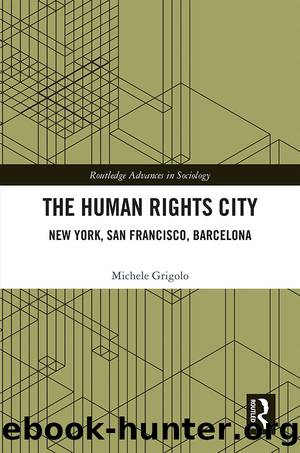The Human Rights City by Michele Grigolo

Author:Michele Grigolo [Grigolo, Michele]
Language: eng
Format: epub
ISBN: 9780367670825
Google: BVO2zQEACAAJ
Publisher: Taylor & Francis Group
Published: 2020-12-18T03:46:47+00:00
The CHRâs neutral approach to the GIA
All this also explains why the CHR maintained a fairly neutral, even defensive position on the GIA. Under the more conservative administrations of Giuliani and to some extent Bloomberg, the Commission moved away from any proactive engagement in the politics of civil rights in New York. Unlike the San Francisco Human Rights Commission, whose LGBT task force contributed evidence and advocated publicly for the inclusion of gender identity in city law (Currah 2006, p. 4; Wilkinson 2006, p. 197), the New Yorkâs Commission did not engage in any research or reporting around the GIA, like it did for the SOA. In fact, under Giuliani, the AIDS Discrimination Unit was âdismantled.â16 Chair Varela, who at an early stage of the campaign seemingly provided NYAGRA with a legal opinion suggesting that only transsexual people were covered under the HRL (from which it could be derived that broader protection based on gender identity was needed), later embraced the same legal opinion that informed Giulianiâs position on the GIA, that the amendment was unnecessary (Park 2007b).
At the same time, while removing itself from any political discussion about the GIA and the necessity of it, the Commission became a site in which LGBT Commissioners would try to resist and guide mayoral policy on LGBT issues. However, like the case of Matt Foreman suggests, this conversation was seemingly more about the stakes of Commissioners âalliedâ to Bloomberg in policy from which the CHR was actually excluded (or excluded itself). Moreover, negotiations do not appear to have concerned the GIA or the politics of gender identity more generally, focussing instead on more established issues of same-sex relationships. Matt Foreman, whom Bloomberg appointed as Commissioner in 2002 while he was heading ESPA, did resign in October 2004 as a matter of âprincipleâ against Bloombergâs challenge to a bill granting health benefits to gay partners employed by contractors with the city. However, he accepted to go back to the Commission in 2005 after becoming Executive Director of the NGLTF (with ESPA supporting Bloombergâs Democratic rival in the forthcoming elections) after the bill was defeated, in exchange for alternative solutions that while ânot a substitute for the billâ were nevertheless considered âa significant move forwardâ by Foreman (New York Post 2005).
The Commission only activated itself once the GIA was approved, to draft guidelines on the meaning and implications of gender identity under the HRL. This step was taken for different reasons, which speaks to ways in which the agency was participating in Bloombergâs governance of the city. In particular, the Commission wanted the âbuy-inâ from civil society agents who had promoted and would use the GIA, to ensure broad consensus and arguably low contestation around the subsequent âlegal implementationâ of the GIA.17 A working group was established within the Commission in which key stakeholders of the amendment participated: Park from NYAGRA but also the Executive Director of the Transgender Legal Defense and Education Fund (TLDEF) Michael Silverman as well as the councillors who had supported the GIA, Matt Foreman and staff from the Commission (NYAGRA 2005).
Download
This site does not store any files on its server. We only index and link to content provided by other sites. Please contact the content providers to delete copyright contents if any and email us, we'll remove relevant links or contents immediately.
The Secret History by Donna Tartt(16747)
The Social Justice Warrior Handbook by Lisa De Pasquale(11514)
Thirteen Reasons Why by Jay Asher(7850)
This Is How You Lose Her by Junot Diaz(5838)
Weapons of Math Destruction by Cathy O'Neil(5091)
Zero to One by Peter Thiel(4878)
The Myth of the Strong Leader by Archie Brown(4816)
Promise Me, Dad by Joe Biden(4489)
Beartown by Fredrik Backman(4479)
How Democracies Die by Steven Levitsky & Daniel Ziblatt(4461)
Stone's Rules by Roger Stone(4448)
The Fire Next Time by James Baldwin(4390)
100 Deadly Skills by Clint Emerson(4120)
A Higher Loyalty: Truth, Lies, and Leadership by James Comey(4071)
Rise and Kill First by Ronen Bergman(4059)
The David Icke Guide to the Global Conspiracy (and how to end it) by David Icke(3929)
The Farm by Tom Rob Smith(3903)
Secrecy World by Jake Bernstein(3818)
The Doomsday Machine by Daniel Ellsberg(3768)
